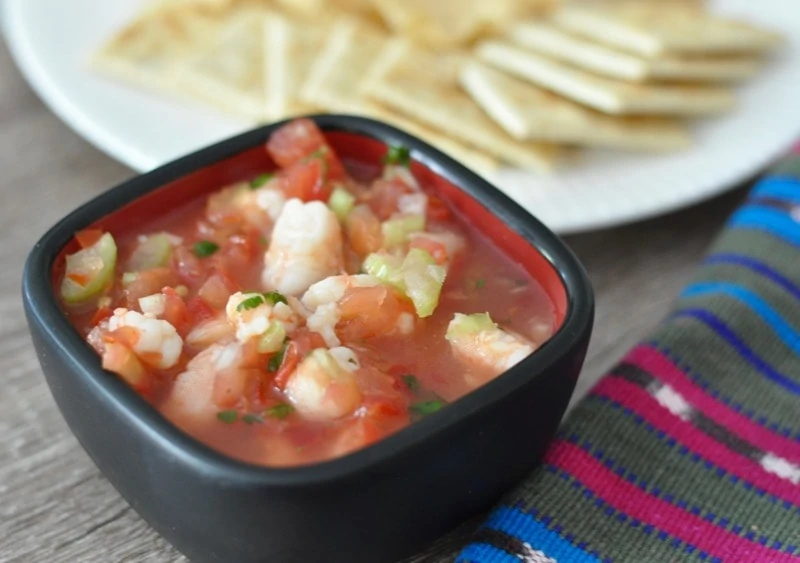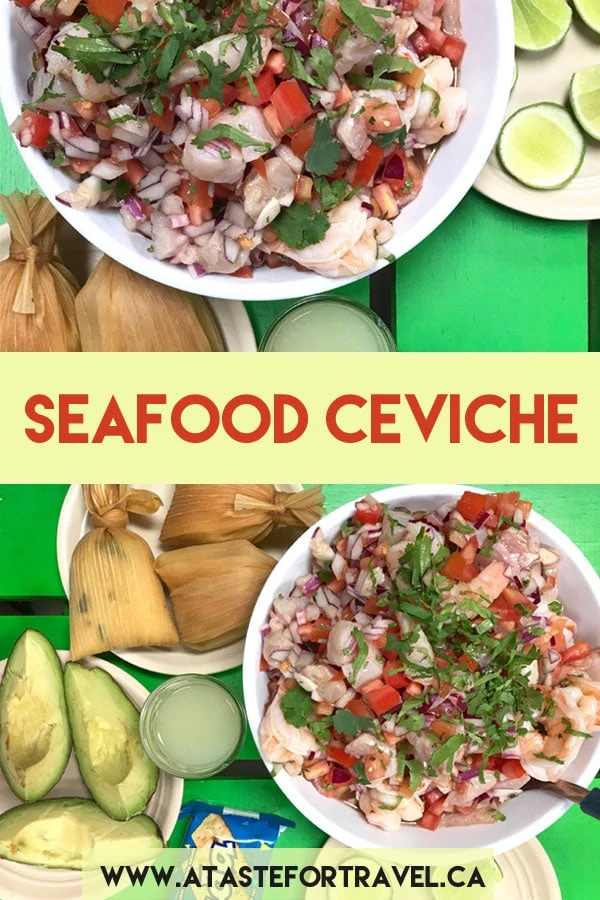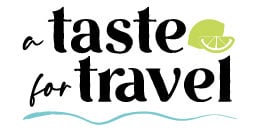We may earn income from links in this post. Please read this Disclosure for details.
This easy recipe for authentic Guatemalan ceviche de camarón features cooked shrimp in a refreshing mix of tomatoes, onion, cilantro and celery in lime juice.
It’s a bright, fresh and zesty shrimp cocktail perfect as an appetizer or snack.

Jump to:
- What is Guatemalan Ceviche?
- Raw Shrimp Ceviche vs Cooked Shrimp Ceviche de Camarón
- How to Avoid Bacteria in Raw Shrimp and Seafood
- Guatemalan Ceviche or Ceviche de Camarón Guatemalteco
- How to Make Guatemalan Ceviche Step by Step
- How to Store and Serve Ceviche
- Variations: Guatemalan Mixed Seafood Ceviche / Ceviche Mixto Guatemalteco
- Recipe
What is Guatemalan Ceviche?
This isn’t just a dish. It’s a Guatemalan ritual. Especially popular in Guatemala City cevicherías or sold right out of the back of pickup trucks in Antigua, this bright, citrusy ceviche is all about flavour and fun.
Made with cooked shrimp, lime, tomato, onion, cilantro, and celery, it’s the go-to for beach days, hot afternoons, or guys’ night with a cold Picosita beer cocktail.
My Guatemalan husband and his friends make this recipe all the time. And they know what’s up when it comes to street food.
It’s such an iconic dish it even appears in the food documentary Somebody Feed Phil at Hugo’s cevicheria in Season 8, released on Netflix in 2025.
Also known as Ceviche Chapín (chapín is slang for someone from Guatemala so it simply means ceviche Guatemalan-style).
Authentic Guatemalan shrimp ceviche is made from fresh seafood cured in lime juice and mixed with chopped onions, cilantro, tomatoes and seasonings.
It’s always served with saltines or tostadas with a bottle of hot sauce on the side.
Much like Salpicon de Pollo (Chilled Chicken, Radish and Mint Salad), garnachas (crispy tortilla snacks) and chojin, ceviche is a light and refreshing dish perfect for a hot day.
Unlike the ceviches of Mexico, in recipes for Ceviche Guatemalteco or Guatemalan ceviche the shrimp is cooked by heat rather than curing.
It’s perfect for anyone who prefers to skip raw seafood, since the shrimp is fully cooked with heat, which helps eliminate any harmful bacteria.
Raw Shrimp Ceviche vs Cooked Shrimp Ceviche de Camarón
Should you worry about getting sick from eating shrimp ceviche?
A purist might argue that authentic shrimp ceviche is, by definition shrimp “cooked” in lime juice. However there are many reasons why people choose to eat shrimp that’s been cooked with heat.
Many restaurant menus caution against eating raw fish of any kind. That’s especially true for people with depressed immune systems, pregnant women, children and the elderly.
The reason for this is that while raw shrimp appears to be “cooked” when it changes colour after being marinated in lime juice, some types of harmful bacteria are only destroyed by high temperatures.
So the solution to making seafood safe for consumption is to precook the shrimp.

If you’ve ever gone through a bout of food poisoning from contaminated ceviche de camaron or other street food, you don’t want to take any chances on getting it again.
A study by the University of Guadalajara indicated up to 14.3% of samples of ceviche collected from street vendors and small restaurants in Guadalajara, Mexico were unsafe. They tested positive for Vibrio cholera, a seafood-borne pathogen that causes a gastrointestinal illness that can be fatal.
While Vibrio cholera cannot exist in an environment that has a pH of less than 4.5, marinating shrimp in lime juice (pH of between 2 and 2.5) should take care of it. However, the operative word is “should”.
Shrimp definitely looks cooks after it marinates in lime juice doesn’t it? But appearances can be deceiving.
Denaturation is the name of the chemical process that happens when a protein is altered through heat or acidity.
With seafood ceviche, acidic lime juice rearranges the chains of amino acids in the same way an oven or cooktop pan does. Yet those changes are only structural. Although the seafood protein structure has been altered, it hasn’t been “cooked” in a way that destroys harmful bacteria.
And Vibrio cholera isn’t the only potential risk. Many government agencies report seafood samples contaminated with salmonella, E. coli and listeria.
In Asia, the government of Hong Kong now recommends patrons check whether premises have a FEHD licence before eating sashimi.
How to Avoid Bacteria in Raw Shrimp and Seafood
As with virtually every type of food, it’s important to handle shrimp and other seafood safely in order to reduce the risk of foodborne illness.
The FDA has prepared a Guide to Fresh and Frozen Seafood that offers several helpful tips about storing, preparing and serving fresh shrimp and seafood.

They note some species can contain parasites and that freezing will kill any parasites that may be present.
So, frozen shrimp can be a great option for making Guatemalan ceviche.
Note that freezing doesn’t kill all harmful microorganisms. That’s why the safest route is to cook your seafood.
Guatemalan Ceviche or Ceviche de Camarón Guatemalteco
While it’s worth noting the above precautions, I’ve personally eaten shrimp and fish ceviche in Mexico while working on Lonely Planet’s Mexico: From the Source cookbook and never once got sick.
I also ate raw fish in Poisson Cru in French Polynesia without any problems.

How to Make Guatemalan Ceviche Step by Step
Begin by peeling and deveining the shrimp. Then cook it in the microwave for 3-5 minutes, depending on the size of the shrimp. Cook in small batches until it is pink in colour.
Save the liquid to use in the tomato mixture you’ll add later. Allow it to cool.
While cooking the shrimp, dice fresh tomatoes, red or mild white onions and celery into small pieces. Do the chopping by hand as a food processor makes the tomatoes too mushy.

In Guatemala, ceviche is often made by two or more people, so the chopping process goes quickly. Once the shrimp has been cooked and cooled to room temperature, chop it into smaller pieces.
The pieces should be larger than the tomatoes and other vegetables.
Combine the shrimp with the V-8 juice, Worcestershire sauce (known as salsa inglesa in Guatemala), jalapeño pepper, cilantro and fresh squeezed lime juice.
Add sea salt to taste.

Chill the shrimp ceviche de cameron in the refrigerator for a few hours. Then serve with saltines, a hot sauce such as Picamas Hot Sauce from Guatemala and avocado. That’s it!
How to Store and Serve Ceviche
- It will stay fresh in the refrigerator for two days.
- Be sure to store it in a glass not metal bowl.

Variations: Guatemalan Mixed Seafood Ceviche / Ceviche Mixto Guatemalteco
- There are many other variations of Guatemalan ceviche. Try ceviche mixto (featuring fish, octopus or pulpo and shrimp) or ceviche de concha negra ( a unique ceviche featuring black clams).
- You can try several of these ceviches at Cevicheria Marea Roja, a sprawling roadside restaurant off the highway in El Rancho Progreso. It’s a great spot for regional Guatemalan cuisine such as tapado, the Garifuna coconut and seafood soup popular on Guatemala’s Caribbean coast. I don’t recommend eating ceviche offered by street vendors in Guatemala City.
- Tip: To make a ceviche mixto at home just substitute your choice of white fish or seafood. Then follow the directions in the recipe card below.
Recipe
Guatemalan Ceviche de Camaron – Shrimp Ceviche
Ingredients
- 10 Roma tomatoes
- 1 pound fresh or frozen shrimp
- 3 stalks celery
- 1 white or red onion
- 1 tablespoon Worcestershire sauce
- 1/2 cup V-8 Juice 5 oz can
- 3 fresh limes to taste
- 1/2 cup cilantro to taste
- 1 jalapeno pepper (seeded) optional
Instructions
- Peel, devein and cook shrimp in batches on medium-high in the microwave for 3-5 minutes until pink
- Dice tomatoes, celery, onions and jalapeno pepper ( if using) into small pieces by hand
- Allow shrimp to cool to room temperature and then combine with chopped vegetables
- Add V-8 juice, Worcestershire sauce, fresh-squeezed lime juice and chopped cilantro. Mix lightly
- Add sea salt to taste
- Chill and serve with saltines and hot sauce
Nutrition
Like this Post? You Might Also Enjoy These:
Salpicon de Res: Shredded Mint and beef appetizer
Pulique: A Ceremonial Chicken from A Mayan Cooking Class in Guatemala
Green Bean Fritters or Tortitas de Ejote Guatemalteco
Pescado Seco Envuelto en Huevo or Bacalao a la Vizcaina
Christmas Eve Salad or Ensalada de Nochebuena
Tortitas de Berro or Watercress Omelettes
Save to Pinterest!




 Sip Moonshine on a ‘Temperance and Temptation’ Getaway in York
Sip Moonshine on a ‘Temperance and Temptation’ Getaway in York
Kavita Favelle
This is a great way of having ceviche for anyone who can’t take the risk of uncooked shrimp but I confess, for me I prefer it “cooked” only by the acidity of the dressing, so it’s closer to its raw texture. I love the flavours in your recipe though and I know I’d enjoy it this way too.
Marie Gizelle
Ahhh…just looking at the photos, I would know it’s yummy! I love shrimp and avocados, this would be on my next “to try” list. Thanks for sharing…
The Girl Next Door
I love this detailed post of yours! I’m sure it will be of great help to several foodies who want to try shrimp ceviche, but are too afraid to do so. 🙂